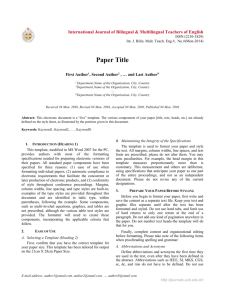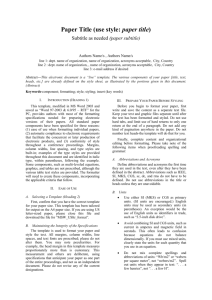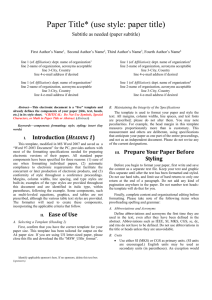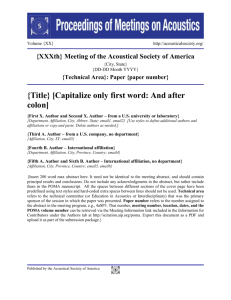Paper Title (use style: paper title)
advertisement
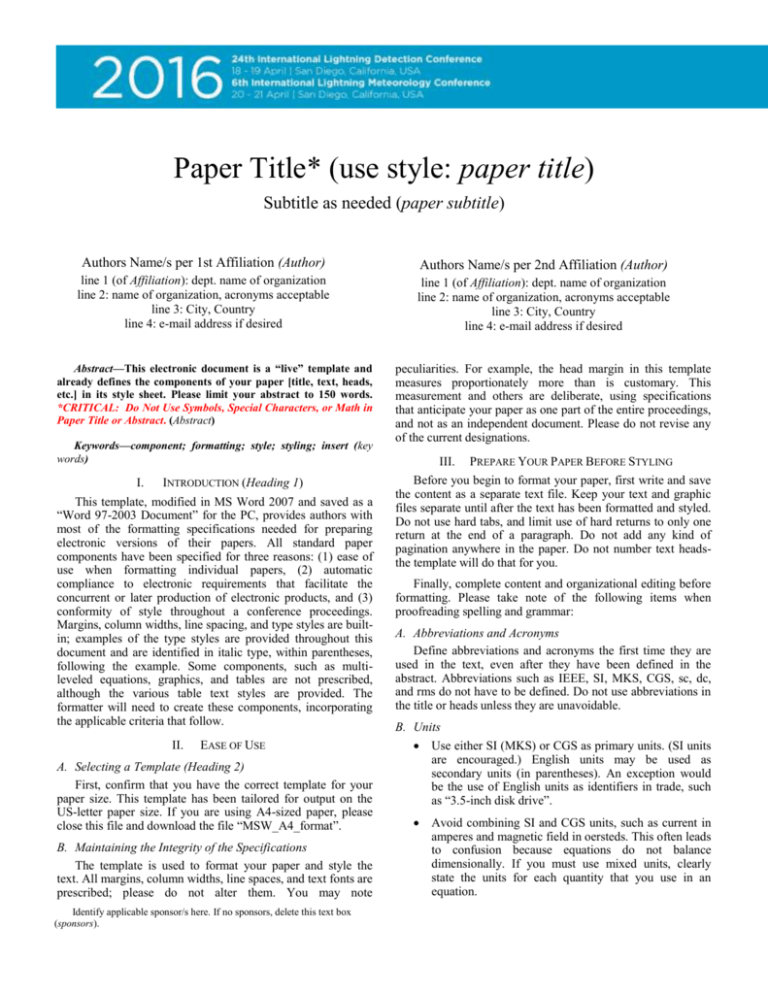
Paper Title* (use style: paper title)
Subtitle as needed (paper subtitle)
Authors Name/s per 1st Affiliation (Author)
Authors Name/s per 2nd Affiliation (Author)
line 1 (of Affiliation): dept. name of organization
line 2: name of organization, acronyms acceptable
line 3: City, Country
line 4: e-mail address if desired
line 1 (of Affiliation): dept. name of organization
line 2: name of organization, acronyms acceptable
line 3: City, Country
line 4: e-mail address if desired
Abstract—This electronic document is a “live” template and
already defines the components of your paper [title, text, heads,
etc.] in its style sheet. Please limit your abstract to 150 words.
*CRITICAL: Do Not Use Symbols, Special Characters, or Math in
Paper Title or Abstract. (Abstract)
Keywords—component; formatting; style; styling; insert (key
words)
I.
INTRODUCTION (Heading 1)
This template, modified in MS Word 2007 and saved as a
“Word 97-2003 Document” for the PC, provides authors with
most of the formatting specifications needed for preparing
electronic versions of their papers. All standard paper
components have been specified for three reasons: (1) ease of
use when formatting individual papers, (2) automatic
compliance to electronic requirements that facilitate the
concurrent or later production of electronic products, and (3)
conformity of style throughout a conference proceedings.
Margins, column widths, line spacing, and type styles are builtin; examples of the type styles are provided throughout this
document and are identified in italic type, within parentheses,
following the example. Some components, such as multileveled equations, graphics, and tables are not prescribed,
although the various table text styles are provided. The
formatter will need to create these components, incorporating
the applicable criteria that follow.
II.
EASE OF USE
A. Selecting a Template (Heading 2)
First, confirm that you have the correct template for your
paper size. This template has been tailored for output on the
US-letter paper size. If you are using A4-sized paper, please
close this file and download the file “MSW_A4_format”.
B. Maintaining the Integrity of the Specifications
The template is used to format your paper and style the
text. All margins, column widths, line spaces, and text fonts are
prescribed; please do not alter them. You may note
Identify applicable sponsor/s here. If no sponsors, delete this text box
(sponsors).
peculiarities. For example, the head margin in this template
measures proportionately more than is customary. This
measurement and others are deliberate, using specifications
that anticipate your paper as one part of the entire proceedings,
and not as an independent document. Please do not revise any
of the current designations.
III.
PREPARE YOUR PAPER BEFORE STYLING
Before you begin to format your paper, first write and save
the content as a separate text file. Keep your text and graphic
files separate until after the text has been formatted and styled.
Do not use hard tabs, and limit use of hard returns to only one
return at the end of a paragraph. Do not add any kind of
pagination anywhere in the paper. Do not number text headsthe template will do that for you.
Finally, complete content and organizational editing before
formatting. Please take note of the following items when
proofreading spelling and grammar:
A. Abbreviations and Acronyms
Define abbreviations and acronyms the first time they are
used in the text, even after they have been defined in the
abstract. Abbreviations such as IEEE, SI, MKS, CGS, sc, dc,
and rms do not have to be defined. Do not use abbreviations in
the title or heads unless they are unavoidable.
B. Units
Use either SI (MKS) or CGS as primary units. (SI units
are encouraged.) English units may be used as
secondary units (in parentheses). An exception would
be the use of English units as identifiers in trade, such
as “3.5-inch disk drive”.
Avoid combining SI and CGS units, such as current in
amperes and magnetic field in oersteds. This often leads
to confusion because equations do not balance
dimensionally. If you must use mixed units, clearly
state the units for each quantity that you use in an
equation.
Do not mix complete spellings and abbreviations of
units: “Wb/m2” or “webers per square meter”, not
“webers/m2”. Spell out units when they appear in text:
“. . . a few henries”, not “. . . a few H”.
Use a zero before decimal points: “0.25”, not “.25”. Use
“cm3”, not “cc”. (bullet list)
C. Equations
The equations are an exception to the prescribed
specifications of this template. You will need to determine
whether or not your equation should be typed using either the
Times New Roman or the Symbol font (please no other font).
To create multileveled equations, it may be necessary to treat
the equation as a graphic and insert it into the text after your
paper is styled.
Number equations consecutively. Equation numbers, within
parentheses, are to position flush right, as in (1), using a right
tab stop. To make your equations more compact, you may use
the solidus ( / ), the exp function, or appropriate exponents.
Italicize Roman symbols for quantities and variables, but not
Greek symbols. Use a long dash rather than a hyphen for a
minus sign. Punctuate equations with commas or periods when
they are part of a sentence, as in
ab
Note that the equation is centered using a center tab stop.
Be sure that the symbols in your equation have been defined
before or immediately following the equation. Use “(1)”, not
“Eq. (1)” or “equation (1)”, except at the beginning of a
sentence: “Equation (1) is . . .”
D. Some Common Mistakes
The word “data” is plural, not singular.
The subscript for the permeability of vacuum 0, and
other common scientific constants, is zero with
subscript formatting, not a lowercase letter “o”.
In American English, commas, semi-/colons, periods,
question and exclamation marks are located within
quotation marks only when a complete thought or name
is cited, such as a title or full quotation. When quotation
marks are used, instead of a bold or italic typeface, to
highlight a word or phrase, punctuation should appear
outside of the quotation marks. A parenthetical phrase
or statement at the end of a sentence is punctuated
outside of the closing parenthesis (like this). (A
parenthetical sentence is punctuated within the
parentheses.)
A graph within a graph is an “inset”, not an “insert”.
The word alternatively is preferred to the word
“alternately” (unless you really mean something that
alternates).
Do not use the word “essentially”
“approximately” or “effectively”.
to
mean
In your paper title, if the words “that uses” can
accurately replace the word “using”, capitalize the “u”;
if not, keep using lower-cased.
Be aware of the different meanings of the homophones
“affect” and “effect”, “complement” and “compliment”,
“discreet” and “discrete”, “principal” and “principle”.
Do not confuse “imply” and “infer”.
The prefix “non” is not a word; it should be joined to
the word it modifies, usually without a hyphen.
There is no period after the “et” in the Latin
abbreviation “et al.”.
The abbreviation “i.e.” means “that is”, and the
abbreviation “e.g.” means “for example”.
An excellent style manual for science writers is [7].
IV.
USING THE TEMPLATE
After the text edit has been completed, the paper is ready
for the template. Duplicate the template file by using the Save
As command, and use the naming convention prescribed by
your conference for the name of your paper. In this newly
created file, highlight all of the contents and import your
prepared text file. You are now ready to style your paper; use
the scroll down window on the left of the MS Word Formatting
toolbar.
A. Authors and Affiliations
The template is designed so that author affiliations are not
repeated each time for multiple authors of the same affiliation.
Please keep your affiliations as succinct as possible (for
example, do not differentiate among departments of the same
organization). This template was designed for two affiliations.
1) For author/s of only one affiliation (Heading 3): To
change the default, adjust the template as follows.
a) Selection (Heading 4): Highlight all author and
affiliation lines.
b) Change number of columns: Select the Columns icon
from the MS Word Standard toolbar and then select “1
Column” from the selection palette.
c) Deletion: Delete the author and affiliation lines for
the second affiliation.
2) For author/s of more than two affiliations: To change
the default, adjust the template as follows.
a) Selection: Highlight all author and affiliation lines.
b) Change number of columns: Select the “Columns”
icon from the MS Word Standard toolbar and then select “1
Column” from the selection palette.
c) Highlight author and affiliation lines of affiliation 1
and copy this selection.
d) Formatting: Insert one hard return immediately after
the last character of the last affiliation line. Then paste down
the copy of affiliation 1. Repeat as necessary for each
additional affiliation.
e) Reassign number of columns: Place your cursor to
the right of the last character of the last affiliation line of an
even numbered affiliation (e.g., if there are five affiliations,
place your cursor at end of fourth affiliation). Drag the cursor
up to highlight all of the above author and affiliation lines. Go
to Column icon and select “2 Columns”. If you have an odd
number of affiliations, the final affiliation will be centered on
the page; all previous will be in two columns.
The preferred spelling of the word “acknowledgment” in
America is without an “e” after the “g”. Avoid the stilted
expression “one of us (R. B. G.) thanks ...”. Instead, try “R. B.
G. thanks...”. Put sponsor acknowledgments in the unnumbered
footnote on the first page.
B. Identify the Headings
Headings, or heads, are organizational devices that guide
the reader through your paper. There are two types: component
heads and text heads.
References are cited by the last name of the author(s) (use
et al. for three or more authors) and the year: [Smith, 1991;
Smith and Allen, 1992; Smith et al., 1993]. If the author's name
is part of the sentence, only the year is bracketed: Jones [1990].
Component heads identify the different components of your
paper and are not topically subordinate to each other. Examples
include Acknowledgments and References and, for these, the
correct style to use is “Heading 5”. Use “figure caption” for
your Figure captions, and “table head” for your table title. Runin heads, such as “Abstract”, will require you to apply a style
(in this case, italic) in addition to the style provided by the drop
down menu to differentiate the head from the text.
Text heads organize the topics on a relational, hierarchical
basis. For example, the paper title is the primary text head
because all subsequent material relates and elaborates on this
one topic. If there are two or more sub-topics, the next level
head (uppercase Roman numerals) should be used and,
conversely, if there are not at least two sub-topics, then no
subheads should be introduced. Styles named “Heading 1”,
“Heading 2”, “Heading 3”, and “Heading 4” are prescribed.
C. Figures and Tables
a) Positioning Figures and Tables: Place figures and
tables at the top and bottom of columns. Avoid placing them
in the middle of columns. Large figures and tables may span
across both columns. Figure captions should be below the
figures; table heads should appear above the tables. Insert
figures and tables after they are cited in the text. Use the
abbreviation “Fig. 1”, even at the beginning of a sentence.
TABLE I.
Table
Head
copy
TABLE TYPE STYLES
Table Column Head
Table column subhead
Subhead
Subhead
REFERENCES
Two or more publications by the same author in the same
year are distinguished by a, b, and c after the year: [Smith,
1989a, 1989b].
Avoid the wording “in Smith [1999]”; use instead, “in the
work of Smith [1989]” or “by Smith [1989].
Organize the reference list by strict letter-by-letter
alphabetization of the first item in the reference, as in the
sequence of Lane, Le Pichon, Macaulay, MacDonald,
McDonald, Sanders, Sandia National Laboratories, St. Amant,
Urey, von Seggern.
List references by the same first author in the following
order:
First author alone, list chronologically, earliest work
first.
One coauthor, list alphabetically by coauthor and then
chronologically.
Two or more coauthors (i.e., cited as "et al." in text), list
chronologically.
Use only initials for first names. Alphabetize different first
authors having the same last name according to the initials of
their first names. If their initials are the same, alphabetize them
by their full names or by the last names of the second authors if
any. Use first author and et al. for more than 10 authors: Smith,
A., et al.
For more information , see the AGU reference document at:
http://www.agu.org/pubs/pdf/AuthorRefSheet.pdf
More table copya
a.
Sample of a Table footnote. (Table footnote)
Fig. 1. Example of a figure caption. (figure caption)
Figure Labels: Use 8 point Times New Roman for Figure
labels. Use words rather than symbols or abbreviations when
writing Figure axis labels to avoid confusing the reader. As an
example, write the
quantity “Magnetization”, or
“Magnetization, M”, not just “M”. If including units in the
label, present them within parentheses. Do not label axes only
with units. In the example, write “Magnetization (A/m)” or
“Magnetization {A[m(1)]}”, not just “A/m”. Do not label axes
with a ratio of quantities and units. For example, write
“Temperature (K)”, not “Temperature/K”.
ACKNOWLEDGMENT (Heading 5)
Brophy, J. G., E. M. Klein, and M. A. Stewart (1999), Textural (Nomarski
interferometry) studies of plagioclase phenocryst zonation styles in
MORB dikes and lavas from the north wall of the Hess Deep Rift, Eos
Trans. AGU, 80(46), Fall Meet. Suppl., F985.
Brown, R. J. E. (1967), Permafrost in Canada, Map 1246A, Geol. Surv. of
Can., Ottawa, Ont.
Budetta, G., and D. Carbone (1998), Temporal variations in gravity at Mt.
Etna (Italy) associated with the 1989 and 1991 eruptions, Bull.
Volcanol., 59, 311–326.
Campbell, J. K. (1970), Mariner Mars 1969, report, Jet. Propul. Lab.,
Pasadena, Calif.
da Silva, R. B. G., M. M. F. Saba, and C. Schumann (2011), Characterization
of intracloud discharges preceding positive cloud-to-ground lightning
strokes in Brazil, paper presented at 14th International Conference on
Atmospheric Electricity, Int. Comm. on Atmos. Electr., Rio de Janeiro,
Brazil.
Heidler, F., F. Drumm, and C. Hopf (1998), Electric fields of positive earth
flashes in near thunderstorms, paper presented at 24th International
Conference on Lightning Protection, Int. Conf. on Lightning Prot.,
Birmingham, U. K.
Henderson, T. (2000), High-pressure metamorphism in the western Llano
uplift, M.S. thesis, 134 pp., Univ. of Tex. at Austin, Austin, 28 June.
Kineman, J. J., and M. A. Ohrenschall (1992), Global Ecosystems Database,
version 1.0, A documentation manual [CD-ROM], Key Geophys. Rec.
Doc. 27, Natl. Geophys. Data Cent., Boulder, Colo.
Liu, H.-L., and J. W. Meriwether (2004), Analysis of a temperature inversion
event in the lower mesosphere, J. Geophys. Res., 109, D02S07,
doi:10.1029/2002JD003026.
Ma, J., D. W. Waugh, A. R. Douglass, S. R. Kawa, and S.-J. Lin (2003),
Evaluation of the transport in the Goddard Space Flight Center threedimensional chemical transport model using the equivalent length
diagnostic,
J.
Geophys.
Res.,
108(D6),
4201,
doi:10.1029/2002JD002268.
Monger, J. W. H., and J. M. Journeay (1994), Guide to the geology and
tectonic evolution of the southern Coast Mountains, Open File Rep.
2490, 77 pp., Geol. Surv. of Can., Ottawa, Ont.
Rakov, V. A., and M. A. Uman (2003), Lightning: Physics and Effects,
Cambridge Univ. Press, New York.
Schiarizza, P., R. G. Gaba, J. K. Glover, J. I. Garver, and P. J. Umhoefer
(1997), Geology and mineral occurrences of the Taseko-Bridge River
area, Bull. 100, 291 pp., B. C. Minist. of Employ. and Invest., Energy
and Miner. Div., Geol. Surv. Branch, Vancouver, B. C., Canada.
Schröder, M., M. König, and J. Schmetz (2009), Deep convection observed by
the Spinning Enhanced Visible and Infrared Imager on board Meteosat
8: Spatial distribution and temporal evolution over Africa in summer
and winter 2006, J. Geophys. Res., doi:10.1029/2008JD010653, in
press.
Sentman, D., H. Stenbaek-Nielsen, M. McHarg, and J. Morrill (2007), Plasma
chemistry of sprite streamers, Eos Trans. AGU, 88(52), Fall Meet.
Suppl., Abstract AE42A-08.

